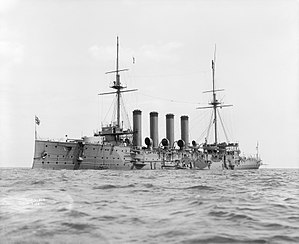| HMS Hogue (1900) | |
|---|---|
 HMS Hogue | |
| Career | |
| Name: | HMS Hogue |
| Namesake: | Battle of La Hogue |
| Builder: | Vickers, Sons & Maxim |
| Launched: | 13 August 1900 |
| Fate: | Sunk by U-9, 22 September 1914 |
| General characteristics | |
| Displacement: | 12,000 long tons (12,000 t) |
| Length: | 472 ft (144 m) |
| Beam: | 69 ft 6 in (21.18 m) |
| Propulsion: |
2 × triple expansion steam engines 2 × screws |
| Speed: | 21 kn (24 mph; 39 km/h) |
| Armament: |
2 × BL 9.2 in (230 mm) Mk X guns 12 × BL 6 in (150 mm) Mk VII guns |
HMS Hogue was a Cressy-class armoured cruiser in the Royal Navy. Hogue was sunk by the German U-boat U-9 on 22 September 1914.
Construction[]
Hogue was built by Messrs. Vickers, Sons & Maxim and launched 19 August 1900. She arrived at Plymouth to be fitted with arms in September 1901.[1]
Service history[]

Launching of the HMS Hogue, August 13th 1900
In June 1906, Hogue served in the 4th Cruiser Squadron on the North America & West Indies Station under the command of Captain Arthur Y. Moggridge.
Shortly after the outbreak of the First World War in August 1914, Hogue was assigned to the 7th Cruiser Squadron, tasked with patrolling the Broad Fourteens of the North Sea, in support of a force of destroyers and submarines based at Harwich which blocked the Eastern end of the Channel from German warships attempting to attack the supply route between England and France.
Fate[]

Victories of U-9 on a Postcard
Hogue was sunk in action on 22 September 1914. At 07:00, about 30 minutes after the action commenced, Hogue was struck by two torpedoes from U-9 as she attempted to rescue survivors from her sister ship, Aboukir. She sank within 15 minutes.
In 1954 the British government sold the salvage rights to the ship and salvage is ongoing.[2]
References[]
- Colledge, J. J.; Warlow, Ben (2006) [1969]. Ships of the Royal Navy: The Complete Record of all Fighting Ships of the Royal Navy (Rev. ed.). London: Chatham Publishing. ISBN 978-1-86176-281-8. OCLC 67375475.
External links[]
The original article can be found at HMS Hogue (1900) and the edit history here.